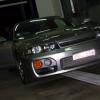Importing problems arise
Announcements
-
Similar Content
-
Latest Posts
-
I did read your post, a few times actually. Done. Followed this step. [Negative probe should be on the cars chassis. Positive on the wire.] Did this partially.. now that im reading this over, i only unplugged the LED lights. [Start as said above by unplugging everything (unplug the lights, and switches.] When you are talking about the switch, you're talking about the knob thing on the right side in the drivers seat right? If so, i need to take that apart? [Now at the switch, there is a wire from the fuse, to the switch, so out your positive on that terminal. It should read open circuit. If it reads something, especially a stupid low value, the short is somewhere between the fuse and the switch.] At this point are you referring to the connector by the headlights? [If that's fine, now put the positive probe on the wire that goes to the headlight (at the switch plug). If it reads stupid low, the fault is from the switch, to the headlight.] Did this. I can confirm that the LED lights aren't the issue [Another quick test, is take the whole LED light setup from the left, and plug it into the right side, does it still blow the fuse? If you put the right hand side led light setup on the left hand side wiring, does the left hand side wiring now blow? If the blowing fuse swaps from right to left doing this, your LED lights are the issue.]
-
Hey was wondering if you ended up installing the R33 GTR speed sensor - I found one too and wanted to confirm it's a direct swap into the R34 6 speed?
-
By njdgomez23 · Posted
After 23 years of owning a Skyline, finally had the latch go. Followed this guide, works like a dream again. Great Guide 👍 -
Hi all, I’ve got the biggest lot of problems with my R33 GTS-T It was a freshly rebuilt 25th anniversary RB25DET (plastic cas, neo cams) probably 6 years ago now The engine was running so well but I fkd up badly and trusted someone I’d known for 10 years that was well known around Plazmaman for his welding and fab work. I added a lovely photo of some of his previous work. Not sure why my car was worked on by whoever did this shit I’m normally someone who would never open myself up to something like this, I still can’t believe I did it. Trusting him literally fkd it all up for me. Everything has been a struggle, like it’s almost been 6 years that’s how much I’ve just on and off been trying to work it all out. All I wanted was a car that danced down low, like full boost from around 3~3500rpm to redline, don’t really care what power it puts down (if it ever does) but I just wanted it to be quick to get on it. He recommended the turbo to get, I picked Hypergear but he told me to get the front 4” with a T4 and 0.68 rear housing. I was expecting all these beautiful welds, tidy fab work and paid for it to be ready to go to a tuner when I got it back. I got a car back that was an absolute mess, I actually couldn’t believe it was my car anymore. I don’t think you could even call what he did welds, they’re disgusting. So I stripped everything he touched off it and with every bolt I loosened it just got worse and worse. I covered it and literally built and finished another car in the meantime but now it’s getting to the point where I really want my Skyline back. Its a struggle because I paid him to do all this shit because I didn’t know how to and now I’ve had to try and figure it all out omg Please excuse the bird shit horrible welds, I’ve got my show pony car and am so beyond dealing with this car I don’t even really care at this point. If someone told me about what he did to my car I wouldn’t have believed them but it happened to me. It was unbelievable. He went missing, my car went missing, it came back missing parts, the straight af chassis rails bore the scars of being dragged up a trailer backwards, even the sandwich plate was bent. Everything was leaking and open to whatever fell into it, rounded off/ missing bolts, power steering oil and coolant everywhere, no gaskets, parts stolen off it, even managed to damage the sump pan. Promised me he’d finish the car, knew what it meant to me, I paid him thousands and thousands just for him to trash it. He told me he was fully licensed and insured, come to find out he’d cancelled his ABN, so obviously no insurance. I had laid up insurance on the car and would’ve been covered but I was scared they would’ve written it off or because the business was no longer trading I’d still be liable. He was supposed to: New fully custom mild steam pipe exhaust manifold with turbo location moved from factory position to high forward mount. (I don’t know if it is a mild steam pipe, I’ve got a funny feeling the waste gate isn’t in a very good position and I don’t think the outlets off each cylinder are equal) 4” custom stainless steel dump with external gate (he re-plumbed it) Cut and shut OEM intake manifold with throttle reposition (I ended up doing the throttle reposition) Box in pod filter (left out) New 100cel catalytic converter (pretty sure it’s there but unsure if it’s 100cel) Front mount intercooler piping fabricated to suit (all smashed up and rusty holes where he was supposed to make it look standard where fmic piping passes through. I don’t even think my front bar is going to fit 🙄) Custom 5” intake pipe from pod to turbo (didn’t come with it so had to do something to make it work with the Z32 afm) Engine: Full cylinder head service & machining Brand new valves Precision upgraded spring kit Engine block honed New bearings New piston rings New ARP conrod bolt kit New ARP head studs Cometic head gasket VRS kit ATR43SS2 ball bearing turbo 0.68 rear housing Turbosmart 45mm external wastegate (got delivered to the fab bloke, I’ve got no idea what spring is in it, I’m assuming the one that came pre installed) Walbro 260 fuel pump Nismo 740cc injectors (tested to 880) Spitfire coil packs GCG FMIC RB25DET manual 5 speed 4:11 rear diff I’ve got an Apexi Power FC in it atm, I was hoping to just get it to operating temp to make sure everything was okay before towing to a tuner but it’s over-fuelling too much. I don’t think that’s going to happen so i think I’m going to get either a Link G4 or Haltech for it. What do you guys recommend? I can’t work out the power FC so just gonna give up on that one It’s got an exhaust leak coming from somewhere I can’t see 🙄 The fuel pressure was steady but now it like drops from 40 to 20psi randomly (noticed this yesterday) I’ll attach pics of the shit he put on my car and the engine bay now as it sits I really just need some help, I need a tuner in Sydney I can trust, I’d like to be with the car while it’s being tuned if possible, I know it looks terrible but unfortunately I’ve just got to put up with it for now and fix the cosmetic stuff later Do you guys think the manifolds are going to be okay? Or do I throw the exhaust manifold and try again? I don’t even think these combinations are going to work tbh I know everything I fitted was rated to be able to take at least 400kW but most rated higher If you’ve gotten this far I really really appreciate it 🙏 I don’t mind if you trash me or the car, I made a rookie error and f**k I’ve paid for it. As you’ll see 🙄
-
From everything I’ve heard you’ll be waiting a long time for the parts to arrive
-






Recommended Posts
Create an account or sign in to comment
You need to be a member in order to leave a comment
Create an account
Sign up for a new account in our community. It's easy!
Register a new accountSign in
Already have an account? Sign in here.
Sign In Now